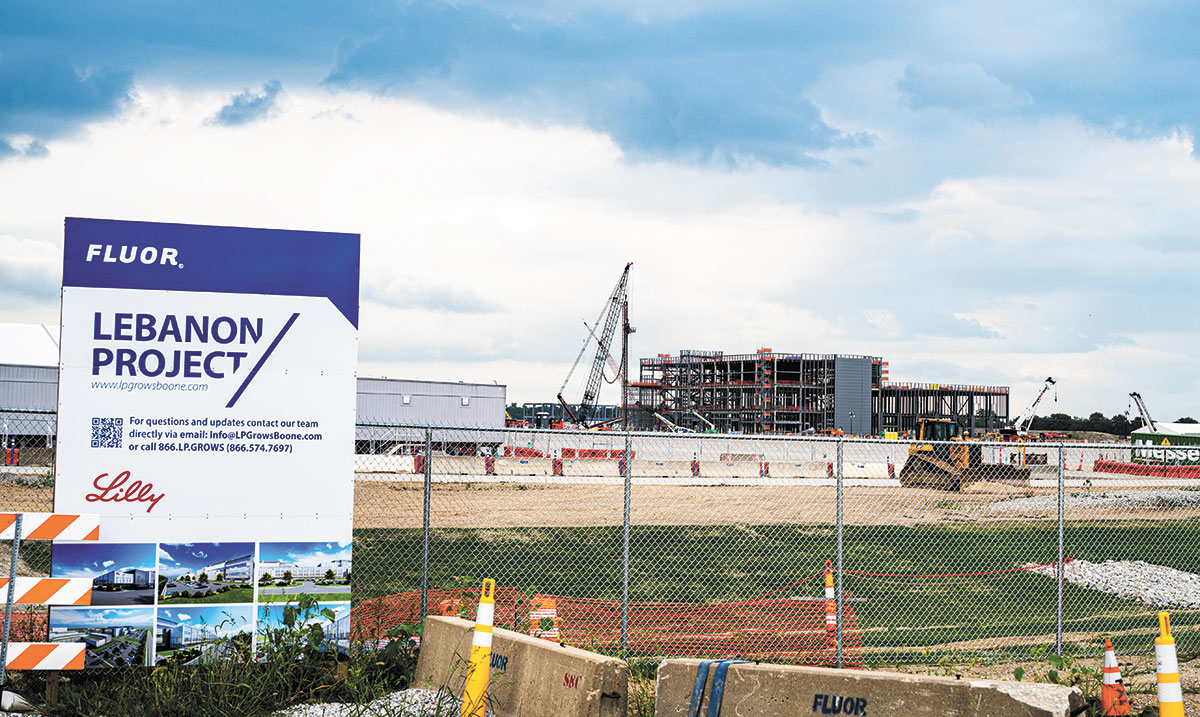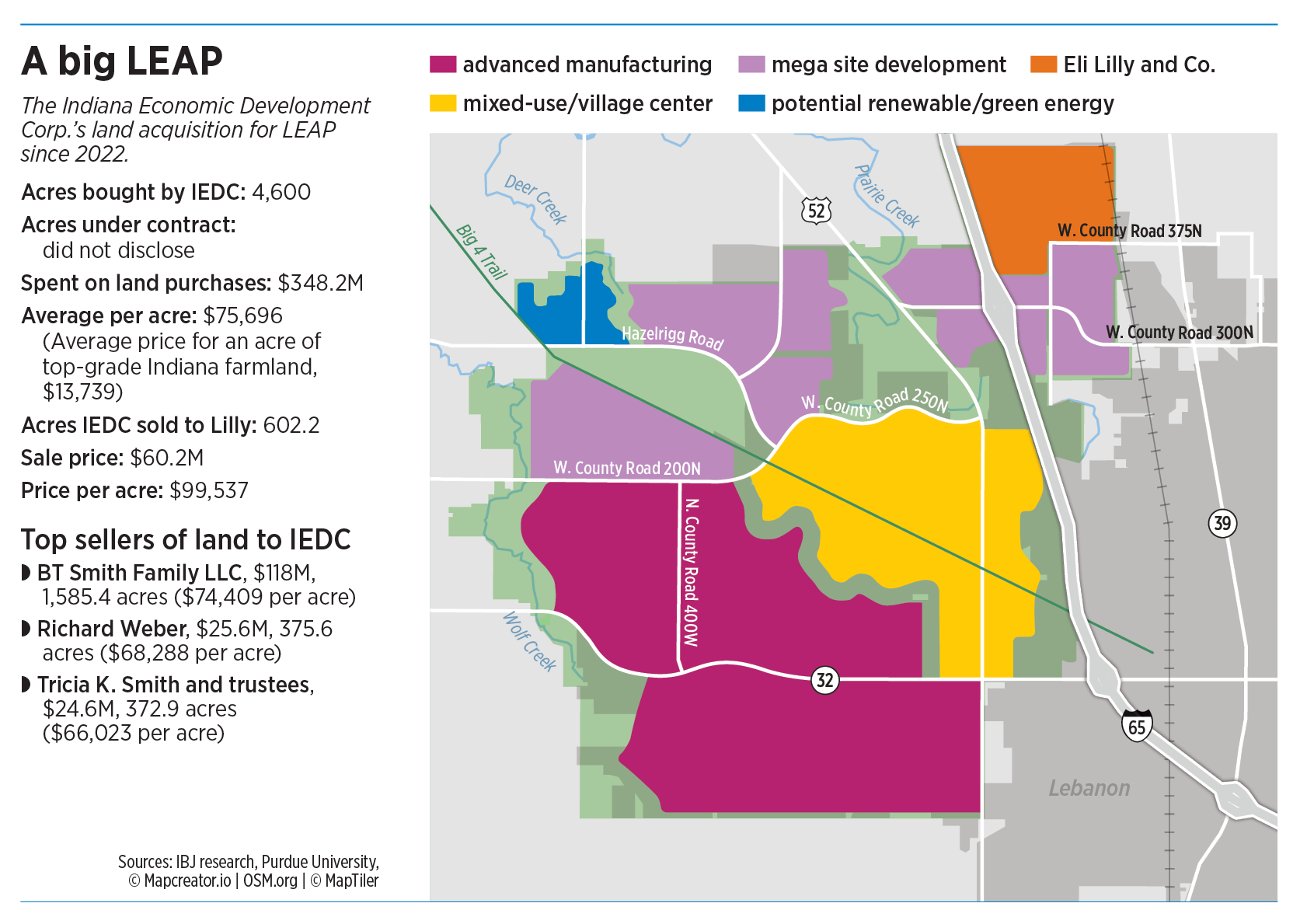Subscriber Benefit
As a subscriber you can listen to articles at work, in the car, or while you work out. Subscribe Now

More than two years after Gov. Eric Holcomb’s Indiana Economic Development Corp. quietly disclosed plans for the 9,000-acre LEAP Research and Innovation District in Boone County, the endeavor’s future now largely depends on the guidance of the next governor.
Neither the strongest advocates nor the harshest critics of the state’s massive and expensive LEAP District have a champion in this fall’s race for governor. Instead, both major-party candidates have maintained their distance from making policy declarations, acknowledging the opportunity the project presents but leaving their vision unclear amid the LEAP site’s unresolved water-access challenges.
What’s unclear is whether the park’s focus could be retooled after state economic development officials already have poured hundreds of millions of dollars into buying 4,600 acres of farmland north and west of Lebanon and have options to buy much more.
The district in Boone County has been touted by the IEDC as a once-in-a-generation endeavor intended to provide thousands of acres of “shovel-ready” plots for the development of manufacturing, R&D and corporate campuses. At capacity, the IEDC believes the park could house hundreds of companies in the life sciences, microelectronics, ag-tech, clean tech, electrification and electric vehicle industries.
Besides a new governor’s direction, the LEAP District’s full potential appears to hinge at least in part on results expected later this year from an Indiana Finance Authority regional water-supply study.
LEAP, which stands for Limitless Exploration/Advanced Pace, has attracted one tenant so far: Eli Lilly and Co., which is building a $9 billion manufacturing complex. The pharmaceutical giant’s ongoing construction reflects a major win for the current administration and ensures that the LEAP District will exist, at least in part, after a new governor takes office.
But even filling the water needs of that one tenant requires additional water supply, something that appears on its way. Citizens Energy and Lebanon Utilities are discussing whether to develop a project that likely would tap into existing water infrastructure in Whitestown and Westfield.
That is expected to serve water needs of the research park and other development in the county for the next 15 to 20 years, officials said. But Lebanon Mayor Matt Gentry has said that doesn’t necessarily rule out the need for something like a 35-mile pipeline from Wabash River aquifers near Lafayette somewhere down the road, especially if a much-sought semiconductor plant, which requires huge volumes of water to operate, decides to locate at LEAP.
The controversial pipeline idea was being explored by the IEDC before the Indiana Finance Authority took over the water study.

Candidates’ positions
Republican U.S. Sen. Mike Braun, the front-runner in the governor’s race, told IBJ he plans to take a practical approach to LEAP that could involve modifying the district to ensure its growth is sustainable.
“We’re gonna have to look at it and see how we keep the best of what it’s about,” Braun said. “And then if necessary, modify it to make sure it’s sustainable.”
“I don’t think it’s going to be impossible to solve and may not be along the original lines or what everybody wanted.”
While the district provides a significant opportunity for the state, Democratic candidate Jennifer McCormick said it needs to be paired with a plan that is “balanced and sustainable.”

If necessary, she said, she would consider LEAP modifications, such as the size of the district, the type of industry, water intensity, stronger environmental standards and better community integration. Those would occur because of a number of factors, including adverse impacts on sustainability, the community, the environment, the state’s economic balance and transparency, she told IBJ in a statement.
“We’re gonna have to be really thoughtful on what has already happened,” she told IBJ in an interview. “The investment has been really already put in. We have a lot of decisions.”
When asked what he foresaw as the future of the district under a new administration, Holcomb told reporters the area continues to have momentum and is “extremely attractive.”
He added that LEAP, since its inception, has never been focused on immediate returns but rather on creating development opportunities over the next one to three decades or beyond.
“It will be an oasis, if you will, of opportunity for people to find great careers that contribute to not only our state’s growth but actually to our nation’s economic and national security,” Holcomb said of Indiana’s effort. “And those are the type of businesses that we’re looking to locate in the LEAP District.”
IEDC Chief Marketing Officer Salena Scardina said in an email that her agency “does not comment on hypotheticals,” such as whether changes could come to LEAP as part of a new administration.
The agency did not make any staff available for an interview for this story, but in a statement doubled down on its commitment to the LEAP district, telling IBJ it considers the early results to be proof-positive that such a project is necessary for the state to compete for megadeals and other companies.
More transparency
The project has been marred by growing public criticism over transparency—enough to spur a statewide debate over local control, city council ordinances barring significant regional water withdrawals and a grassroots group’s outright opposition to a potential Wabash River-focused pipeline.
Both Braun and McCormick have repeatedly said they would have been much more transparent about LEAP’s development and its water needs.
A project of that size should have been “flooded with transparency” from the start, Braun said, to give Indiana residents and economic development officials more reason to see value in the effort.
And while Braun didn’t share specific plans for the district, he said his administration would seek to remedy transparency problems, water concerns and other possible missteps. Those efforts, he said, will help the state reach a resolution that works for all involved in the endeavor.
“There were some things that were done, where we maybe put the cart before the horse,” Braun said. “I’m used to dealing with problems and issues—building a business over 37 years—and this will fit into how you take the best of what you got, the amount of what already is out of the bag and figure out what makes sense down the road.”
McCormick expressed similar concerns, saying the decision-making thus far has not been thoughtful—creating a difficult balancing act between spurring high-paying jobs and making sure enough water is available to support them. She said economic development projects of this size should first be considered for their impact on the state as a whole.
Under her leadership, she said, decisions on the district would require data proving the value of moving forward on further development of the campus.
“Step one would [be to] get honest data and information that we can gather to make some good decisions about how to best proceed,” she said. “I questioned the legitimacy of some of that information that’s been presented, so [it’s about] making sure we have a non-biased input.”
Other considerations
The next few months are peppered with state-level decisions that could redirect the project outside direct commands from a new governor.
Each candidate has promised the state would take on a new economic development direction under their lead—one that is more focused on spreading opportunity around the state instead of on bagging large-scale investments.
Braun said his administration would not prioritize major investments over small-business growth—though he has said the state has done a good job generally with economic development. When it comes to the IEDC, which oversees LEAP, he said he would evaluate the agency’s operation and staff like he would every other department.
“There is what I would consider entirely too much of government involvement in choosing winners and losers,” he told IBJ, “and in forcing economic development that [government officials] choose to be the proper pathway.”
McCormick also said balance is needed between extensive, multibillion-dollar projects and small business, especially when it comes to rural and small-town development.
While the state has done well to gain commitments from large companies, she said, this type of planning needs more local control and direction. In an interview with IBJ, she said the lack of oversight of the IEDC has given it “a blank checkbook.”
“The LEAP district is an ambitious initiative with the potential to drive significant economic growth in central Indiana,” she said in a statement to IBJ. “However, it is essential that this vision doesn’t come at the expense of economic development in other regions of the state.”
State lawmakers and interest groups have been prepping to tackle reform of the state’s water policy next year, which could have ramifications for the LEAP project. Bills seeking to reel in the IEDC’s power and leash for secrecy might also re-emerge.
Regardless of who might be elected in November, Holcomb and Secretary of Commerce David Rosenberg continue to pursue development at LEAP and court major investments. State officials and several IBJ sources say a glut of projects are in the pipeline that they think could lead to a drastic positive shift in attitudes about the sprawling campus.
“I am optimistic that there will be much more good news to share before I hand over the keys” to the Governor’s Office in January, Holcomb told reporters in late July.•
Please enable JavaScript to view this content.


The LEAP initiative needs to proceed at full speed. The potential positives for Indiana are huge.
With 9,000 acres already under control, the Indiana LEAP District is a truly massive development, comparable in size to central Boston, Washington D.C., Singapore, or even the entire city of Geneva, Switzerland. To put it in perspective, the LEAP District is significantly larger than two of the country’s largest business parks: Raleigh-Durham’s Research Triangle and Chicago’s O’Hare International Center, both of which have been developing as hubs for innovation and business since the 1950s.
Indianapolis and Central Indiana are competing with these areas and others for top-tier knowledge workers. While the availability of land and the overall size of the LEAP district are compelling, what truly makes a region attractive to employers isn’t just that, or tax incentives, of nearness to a major research university. Most importantly, it’s about creating an environment where highly skilled workers WANT to relocate and stay—a place that offers the most vibrant communities, the greatest mix of the highest quality-of-life attributes, neighborhood lifestyle options with the kinds of vitality that one can find in these other cities and beautiful places including, yes, at the core of it all, a thriving, dynamic, and amenity rich capital city center that appeals to people who can live anywhere they choose.
For Central Indiana to succeed in attracting and retaining this talent, it’s crucial that we enhance our offering in these areas. This equires a shift in vision and priorities—investing in visionary megaprojects and amenities that strengthen the city’s core, beyond the typical focus on sports arenas and convention center expansions. If we fail to create the vibrant, attractive places and spaces, we risk falling short in our ability to build a more dynamic, innovative economy. Instead of simply expanding ever outward, we need to focus on building a strong, vibrant core so the broader region and the entire state can compete with the greatest and most dynamic cities and regions in the world.
Well said!
This will not happen in Indiana without significant investments in both K-12 “path to college” education and “quality of place”.
Neither of those will happen in a state where “low taxes forever” is the working theory of government. Read anything recent by Michael Hicks.
The type of people you describe are not attracted to the rampant Trumpism in this state. And even if they are willing to move here, they will need water to drink…
I would have preferred if they would have transparently solved the water issue before investing in the land. I really don’t like the idea of arbitrarily moving water from another aquifer. This smells to me like the Colorado River issue all over again.
Without scientific research (transparency?) that’s where were headed.